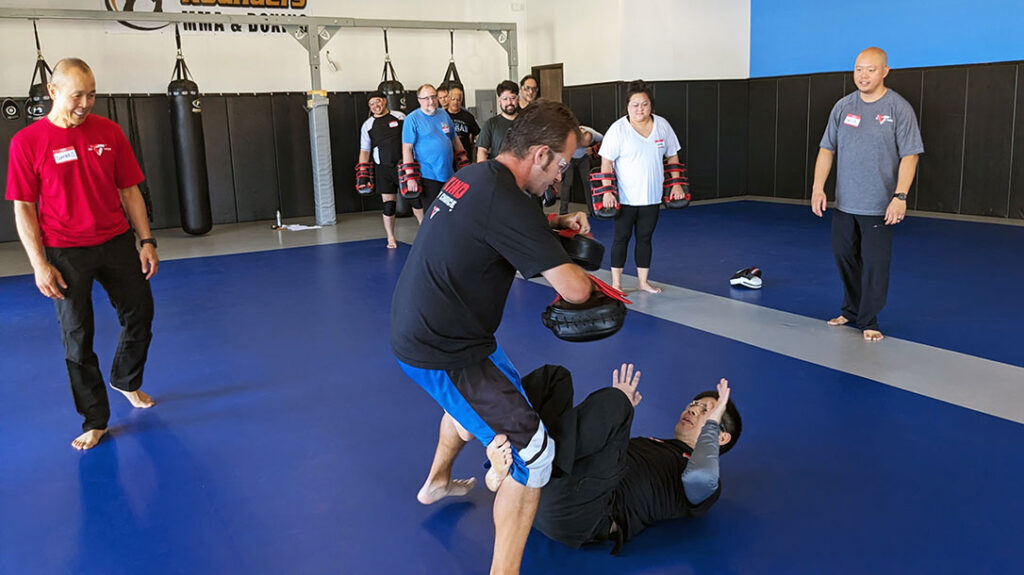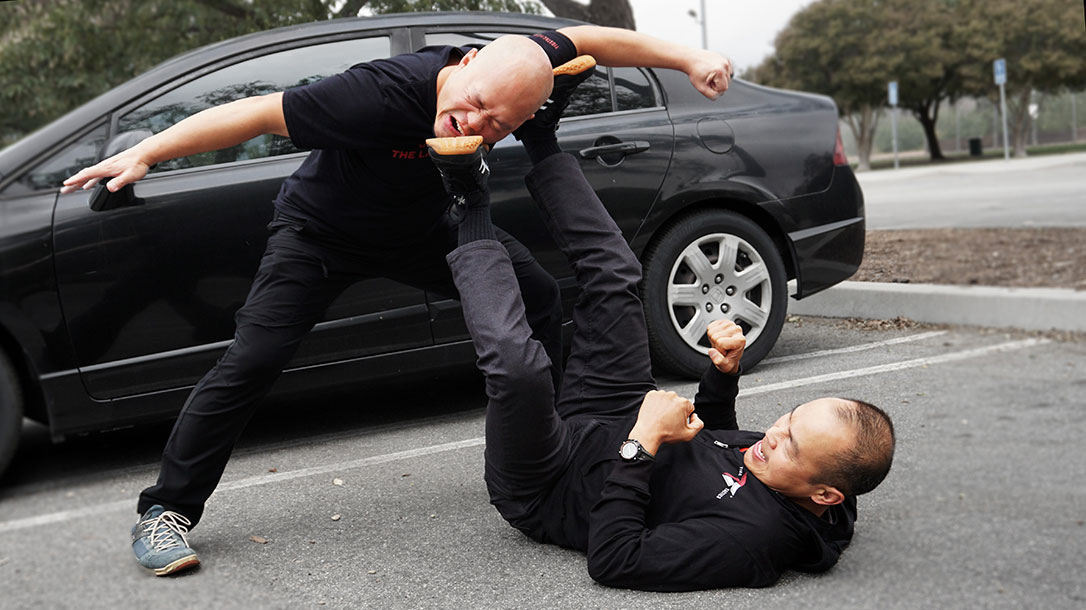There’s a tendency for those of us who are firearms enthusiasts to be overconfident in our ability to handle many common self-defense situations. “I carry a handgun, so I’m good,” is the usual line of reasoning. I was guilty of that myself and had become a bit complacent about having a more comprehensive self-defense strategy. It was time to get back on track. I did that by attending a Street Combatives Seminar conducted by Tiga Tactics.
Self-Defense Training with Tiga Tactics
The outfit is run by lifelong martial artists skilled in several disciplines. The company boils self-defense strategies down to basic, easy-to-learn techniques that address how conflicts are most likely to occur in real-world situations.
The course renewed my dedication to working on what I believe are the ten steps to being better prepared should I find myself fighting for my life.
Advertisement — Continue Reading Below
1. Physical conditioning
Many situations stem from a close-quarters ambush attack or an argument that degenerates into pushing, shoving, punching, or grappling. If you’re losing that fight when your assailant decides to introduce lethal force, you might not have a chance to deploy weapons of your own.
“What a lot of people are not aware of is that a fight is physical,” said Patrick Vuong, co-founder of Tiga Tactics. “Fighting is a total head-to-toe experience. You can’t be prepared for it by reading about it or watching YouTube videos. It’s very important to be physically fit.
“If you don’t have the endurance, the cardio, the muscular development, the reflexes, the timing, you’re going to be behind the curve. And most of the time, in a physical fight, you’re already behind the curve because the bad guy is going to take you by surprise.”
Advertisement — Continue Reading Below
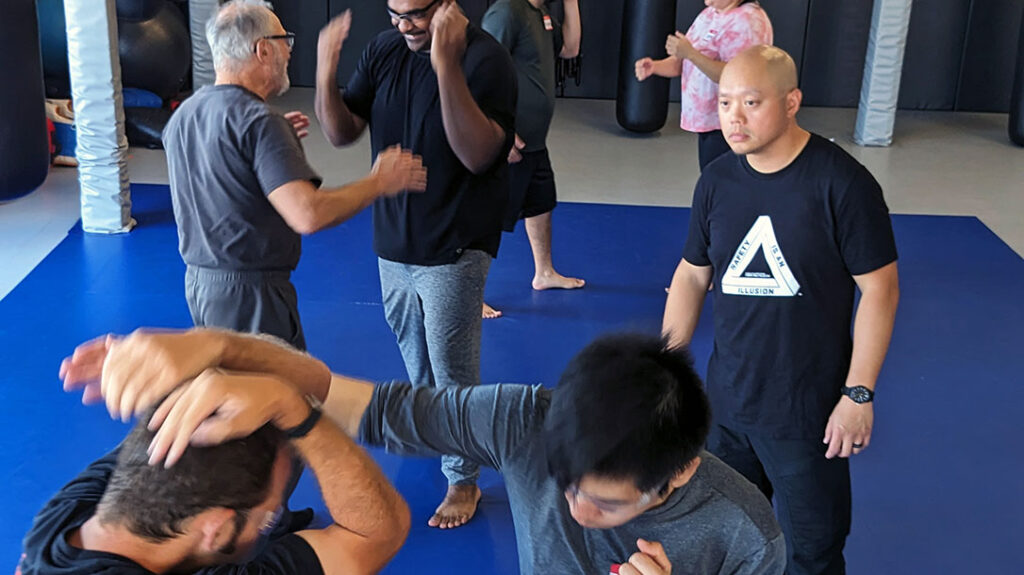
2. Empty-hand techniques
“I think a lot of people have watched too many movies and TV shows and assume that they will be able to see an attack coming from 21 yards away and that they will be able to deploy self-defense tools in time,” said Vuong.
“They don’t realize that criminals will wait until the very last second to attack you when you least expect it. I call them ‘urban ambushes,’ but it doesn’t necessarily have to happen in a city. They’ll sneak up on you or trick you into lowering your guard, and that’s when they will clock you with a sucker punch, pull out a knife and stab you or pull out a gun and shoot you up close and personal.
Advertisement — Continue Reading Below
“Most attacks happen within six feet. Even if you carry concealed or have a pocket knife, flashlight, or pepper spray, a guy within six feet will reach you in less than a second. How are you able to draw that self-defense tool in time before you’re punched, stabbed, or shot? So, it’s very important to be able to address those threats when you have nothing in your hands.”
In the Street Combatives Seminar, we worked on basic skills. This included palm and elbow strikes, knee kicks, and grappling defenses to prevent being taken to the ground. We also worked on what to do if we did end up on the ground.
3. Smart gear choices
“Some people focus on what I call ‘toys’—fancy, trendy accessories, the aesthetics,” said Vuong. “They should focus on what makes them the most prepared and not what looks cool.”
Advertisement — Continue Reading Below
How and where on your body you carry are critical to your success. A tiny pistol chosen for carry convenience won’t help much if you can’t shoot it well. A holster that doesn’t properly secure the weapon can be a liability if your gun goes sliding across the pavement during a scuffle.
A sturdy belt and clothing that conceals while still allowing unencumbered access to your weapon are equally important.
“That whole dynamic should be considered before you even leave the house,” said Vuong.
Advertisement — Continue Reading Below
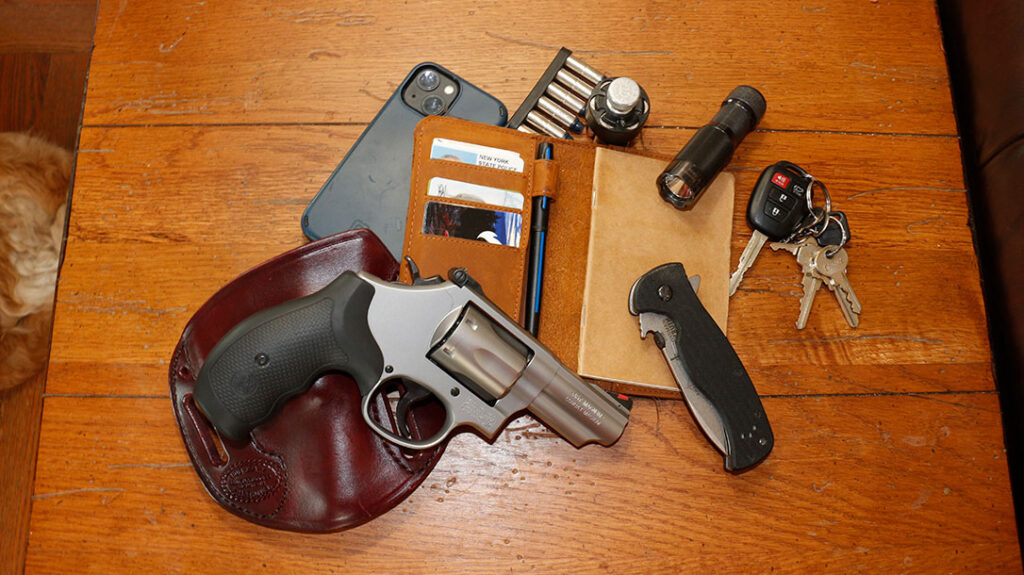
4. Not just guns
Careful consideration should be given to other self-defense tools like pepper spray, impact weapons, stun guns, knives, and flashlights. This will help you better decide where they fit into your overall self-defense plan without being over-reliant on these tools.
“I believe in stacking the deck. Being as ready and prepared as possible, but not to the point where your entire focus is on the toolset,” said Vuong. “The emphasis should be more on your skillset and, most of all, on your mindset.
Advertisement — Continue Reading Below
Knowing what to expect from these tools realistically and how to carry them are important considerations. Vuong used the example of a woman who buys a stun gun and puts it in her purse.
“She’s just added two more steps to her self-defense response because now she has to index her purse, unzip it, and then reach in to draw the stun gun. She’s going to be that much slower when the bad guy is attacking.
“Figure which tools are right for you and then how to incorporate them into your everyday life. I like flashlights because you can take them just about anywhere, and they make for great impact weapons.”
Advertisement — Continue Reading Below
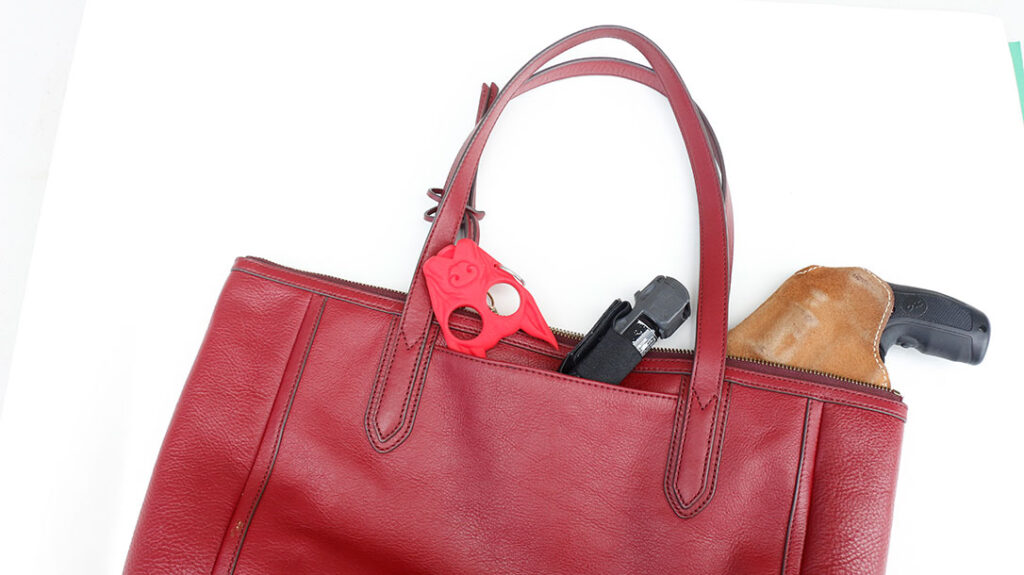
5. Awareness
Keeping your face out of your phone and maintaining situational awareness can help you to anticipate bad situations.
“If you can avoid, evade, or escape danger, then you won’t have to fight in the first place,” said Vuong. “Living a smart lifestyle is extremely important. Don’t break the Law of Stupid: Don’t do stupid things with stupid people in stupid places at stupid times.”
Advertisement — Continue Reading Below
An excellent resource for learning how to form good awareness habits is the book, “Spotting Danger Before It Spots You: Building Situational Awareness To Stay Safe” by Gary Quesenberry.
6. Teamwork
You might not be alone when bad things happen. You must know who has particular skills and capabilities and, at the very least, be able to use good communication. That includes keywords used to communicate discreetly that there’s trouble and what actions you need to take.
“Unfortunately, most people don’t communicate this with their loved ones,” said Vuong. “Violence doesn’t happen in a vacuum. It sometimes happens in public with people around.”
He said that if the person you’re with doesn’t train with you, then that changes the whole dynamic. Instead of a team of two, you’re more like a bodyguard. Then, a bad situation is not only a matter of how you defend yourself but how to get your loved one out of there safely.
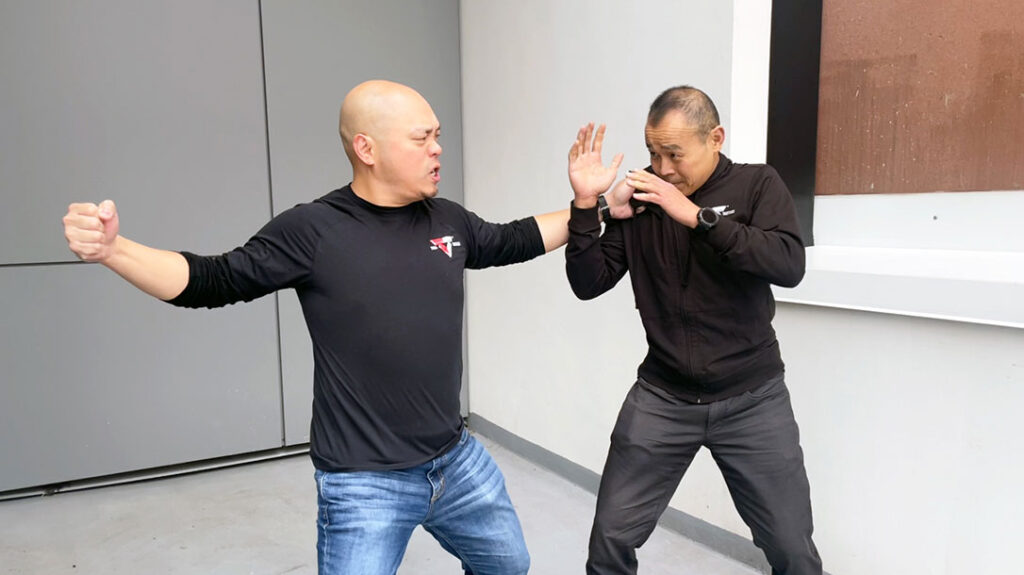
7. “Homework”
How secure is your home? Check locks, cameras, lighting, and early warning devices such as alarms or barking dogs.
“A home emergent plan is very key, and if you live with other people, it’s very important that they all get on the same page with it. But there needs to be a balance. You should be prepared for a home invasion. But not to the point where it becomes obsessive, and you’re not able to relax in your own home.”
Vuong pointed out that teamwork is also important in the home, with everyone understanding their roles. Ensure that children know to hide in a designated space. Maybe one person is assigned to get a flashlight and firearm while another calls 911. Plan to meet in the same location so there are no accidents caused by friendly fire.
8. Backup plan
So, what happens if things don’t go as planned?
“It’s very important not to over-rely on the tools,” said Vuong. “Plan A should always be: How do I get out of this confrontation without it getting physical? Plan B could be: Maybe I can use my empty-hand skills to subdue them.
“This could mean a quick palm to the nose or a kick to the groin, using grappling skills to throw them to the ground, or pinning them to the ground and holding them there until someone can call 911.
“The next step in the progression would be when you realize: This has gotten very serious. Now, it’s a matter of life or death. How do I make room with my empty-hand skills so that I can draw my self-defense tools and end this as quickly as possible?”
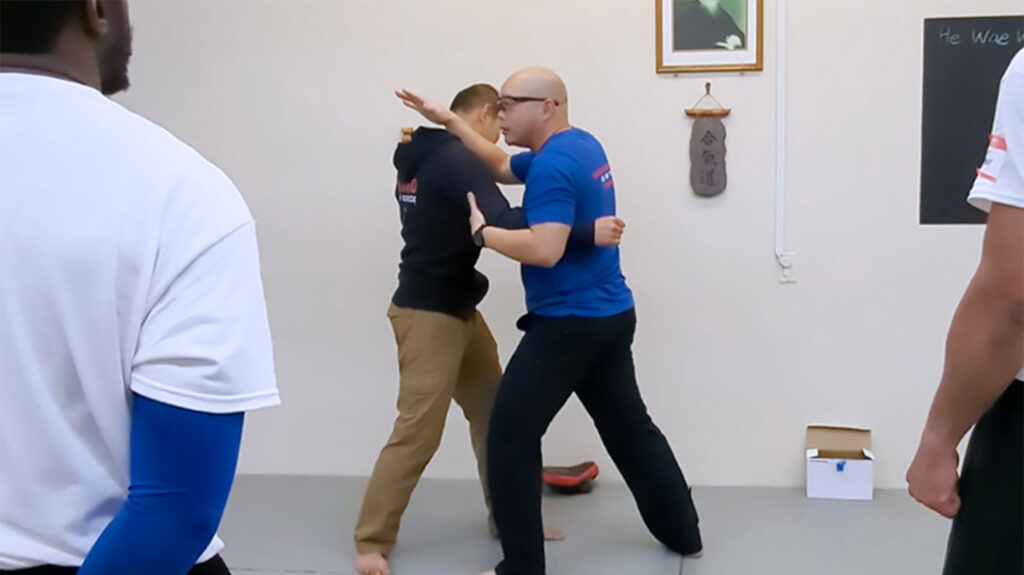
9. Training and education
Choose to spend some time training. But you don’t want your practice sessions to reinforce bad habits.
“It’s very important to seek out qualified instructors of specific subjects to improve your self-defense readiness,” said Vuong. “That face-to-face time, time on the mat, time at the range, time in the boxing ring, that’s irreplaceable.
“You only have so much time, only so many years. So why not spend those years training with something that will help to prepare you for a violent situation and also get you extremely fit? And hopefully, it will be fun to do, so you’ll stick with it.”
10. Consistency
Practice continual situational awareness, carry your defensive tools whenever possible, and train regularly with those tools and your physical defensive skills.
“Keeping things simple is the key to success in a violent situation,” said Vuong. ”When violence happens, the adrenalin dump kicks in, you get tunnel vision, you start to lose a bit of your hearing, you can’t communicate very well, you start hyper-ventilating, there are all of the physiological side effects that can happen. So, if you’ve trained to do extremely complicated things with fine motor control, all of that’s going out the door.
“You need very simple gross motor skills to overcome the fact that you’re going to have that adrenaline dump, and if you don’t want to freeze, you have to use very simple movements. And that’s where the consistency in training comes into play.”
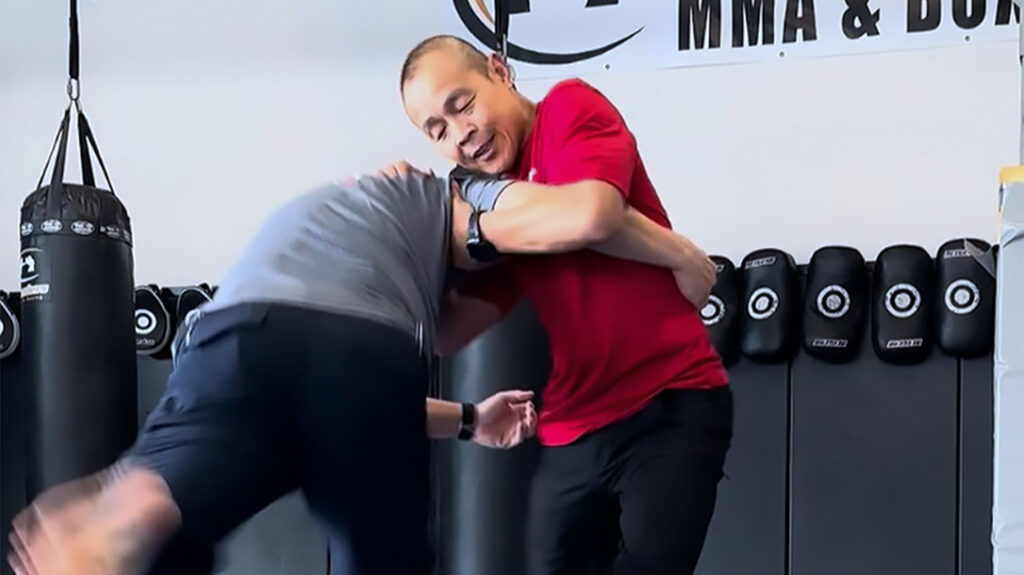
Tiga Tactics Offers a Wide Range Of Courses
Tiga Tactics is a California-based martial arts academy founded in 2018 by Dr. Conrad Bui and his cousin, Patrick Vuong.
The firm hosts self-defense seminars on both coasts, including the Street Combatives Seminar I attended in Maryland. There are also many online courses available.
These include Pistol Defense (unarmed defense against a gunman), EDC Knife, Knife Defense, EDC Flashlight, EDC Karambit, Anti-Grappling/Takedown Defense, Impact Weapon Defense, Machete Fighting, and others.
Dr. Bui is a 5th-degree Black Belt in Freestyle Karate and Tae Kwon Do. He’s an instructor in Kuntao Silat, De Thouars, Ying Lung Hsing, Silat Serak, and Nubreed Kali. He also coaches and competes in Brazilian Jiu-Jitsu and Muay Thai.
Vuong holds black belts in Kenpo Karate and Kung Fu. He is also a student of Silat Serak, Muay Thai, and Brazilian Jiu-Jitsu. In addition, he is an instructor in the bladed art of Pekiti-Tirsia Kali. Both Vuong and Dr. Bui are certified pistol instructors as well.
For more information, go to TigaTactics.com.
